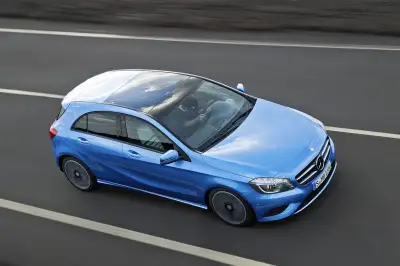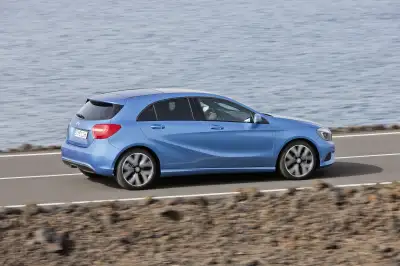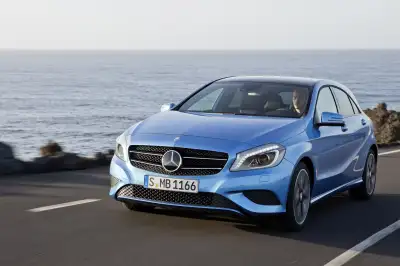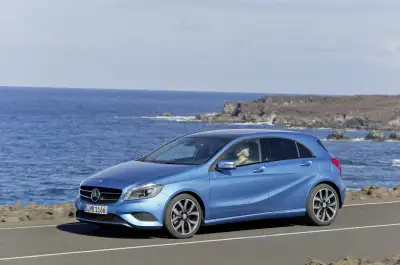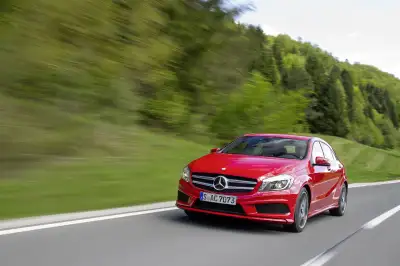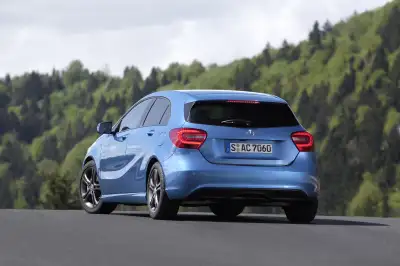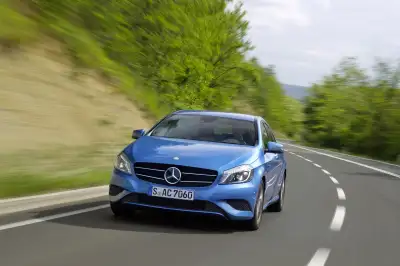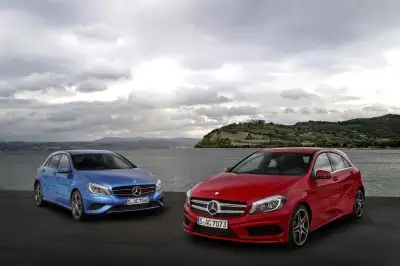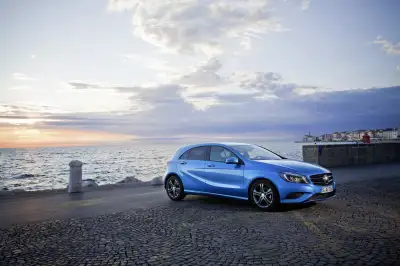New Mercedes A-Class
"Mercedes-Benz is becoming the most dynamic premium brand in the world. As part of this development, the A-Class represents an important milestone. The A-Class is completely new, down to the last detail. In automotive development, it's not often you get the chance to start with a clean sheet of paper. Our engineers have made the very most of that opportunity", explains Dr Dieter Zetsche, Chairman of the Board of Management of Daimler AG and Head of Mercedes-Benz Cars.
The design: the most progressive in the compact class
Standing as much as 160 millimetres lower on the road than the preceding model, the new A-Class communicates design and dynamism at the very first glance. This radical form language, presented and enthusiastically acclaimed around the world with the Concept A-CLASS, was consistently implemented in the series production car. The appearance of the new A-Class reflects this new Mercedes-Benz design strategy. The result is what is known as a two-box design with a distinct character of its own, a sportily emotive exterior and an exceptionally high-quality feel to the interior.
"Translating the new dynamic style of Mercedes-Benz into the compact class was a challenge that was great fun to tackle", explains Gorden Wagener, Head of Design at Mercedes-Benz. "No other car in this segment is as progressive as the A-Class. Absolutely typical for Mercedes is the sculptural shape of the A‑Class. The character lines, in particular on its sides, lend the A-Class structure and terseness. The new dynamic style is perceptible at first glance in the interior as well."
Defined edges and tautly drawn surfaces mark out the exterior design of the new A-Class. The constant interplay between concave and convex surfaces creates a characteristic play of light, particularly along the sides of the car, which contributes to its unique appearance.
Typical features of the long, sporty front are its pronounced V-shape, the separate headlamps, the radiator grille with central Mercedes star and double slats to either side of the star, as well as the additional air intakes on the sides. The "dropping line" apparent in the side profile dissipates towards the vehicle's front end. The design of the headlamps, together with the configuration of the light functions within them, are key elements of the design concept. The light modules and LEDs behind the headlamp cover glass have been arranged in such a way as to create the characteristic "flare effect" for the daytime driving lights and indicators.
The perfect interplay of dynamic design and excellent aerodynamics is nowhere more apparent than in the roof, with its smooth surfaces and taut, arcing curve. The silhouette reveals smooth, flowing lines finishing in a flat edge. The roof spoiler, which conveniently hides all the aerials, provides an extra sporty touch and gives structure to the roof assembly.
The broad emphasis of the tail end is revealed in an interplay of convex-concave surfaces and edges. The tail lights continue the line of the muscular shoulders back towards the rear, while their horizontal orientation emphasises the car's powerful width. The light functions are provided optionally by fibre-optic cables and LED modules. Here, too, the interaction between design and aerodynamics is very clear: the surface finish of the tail lights is not only an interesting design feature, but also improves the airflow around the vehicle thanks to defined airflow break-away edges in the rear section.
Interior: five-seater model with a high-value impression
The interior of the A-Class represents a big step forward in terms of quality – both in the materials used and in the consistency of the design. Both objectives have been achieved with the help of a specific design idiom and through the various combination options possible with the high-quality materials selected. All trim elements have been given an electroplated finish, resulting in real metal surfaces with "cool touch" effect. The work has been executed with considerable care and attention to detail, so that they appear to have been moulded in one piece.
The instrument panel incorporates five round vents. The outer rings of the round vents have a high-quality electroplated finish. The airflow direction is governed by an insert that is reminiscent of an aircraft turbine and reveals a meticulous attention to detail. This too has an electroplated finish in silver-chrome. The free-standing display screen features a black piano-lacquer-look front panel and a flush-fitting silver frame.
The instrument cluster comprises two large round instruments, each with a small dial set within it. When at rest, the dial needles stand at 6 o'clock. The pointer inlays are in white, although with the sportier design and equipment lines such as Urban and AMG Sport they are in red. The dials on the sporty equipment lines and packages are silver with a chequered flag effect. The 3-spoke steering wheel comes with 12 function buttons and an electroplated bezel.
The fact that the new A-Class is a sporty hatchback model with a low centre of gravity is reflected in its dimensions: measuring 4292 x 1780 x 1433 mm (length x width x height),it hugs the road. Compared with its predecessor, which followed a different design, the height has been reduced by 160 millimetres.
The A-Class is a five-seater model. The rears seats provide room for three passengers, despite looking like two individual seats with their sporty design. The boot volume is 341 litres, based on the VDA standard. If the rear seat backrests are folded down, its capacity jumps to 1157 litres. In all models the seat backrests feature a 60:40 split can be folded forward individually. The width of the luggage compartment between the wheel housings is 1050 mm.
The model range: young and individual
With air conditioning, Audio 5 USB, electric windows all round, Headlamp Assist and 12-button multifunction steering wheel, the A-Class is already fully equipped even in its base configuration. With "Urban", "Style" and "AMG Sport" appointment lines, three Design packages ("Night", "Exclusive" and "AMG Exclusive") as well as further optional extras, the model can be customised to suit every individual taste.
Available appointments, many familiar from higher vehicle classes, include the Intelligent Light System, electrically adjustable front seats with memory function or dashboard finished in ARTICO man-made leather (part of the Exclusive package). All three appointment lines feature front sports seats with integrated head restraints and contrasting stitching, and can be combined with all engine variants. Further sporty details designed to appeal to the vehicle's young target group include designo seat belts in red (available from December 2012) or silver instrument cluster with red dial pointers (part of the Urban and AMG Sport lines as well as the Exclusive and AMG Exclusive packages). "The new A-Class is the heartbeat of a new generation at Mercedes-Benz", stresses Dr Joachim Schmidt, Member of the Board of Management of Mercedes-Benz Cars responsible for Sales & Marketing. "We have taken the opportunity to design a completely new vehicle which sets standards in its segment. I am convinced that the new A-Class will make a significant contribution to our Mercedes-Benz 2020 growth strategy." Drive system: high output, low consumption A wide choice of petrol and diesel engines meets every power requirement and reaches new heights in terms of efficiency and environmental compatibility: the A 180 CDI will be the very first Mercedes-Benz to emit only 98 g of CO2 per kilometre. Moreover, the A 220 CDI (available from December 2012) already meets the Euro 6 emission standard which only comes into force in 2015. All engines of the new A-Class feature the ECO start/stop function as standard. The engines can be combined with the new six-speed manual transmission or optionally with the 7G-DCT dual clutch automatic transmission, which ideally combines comfort and sportiness. Fuel consumption down by up to 35 percent compared to comparable preceding models, accompanied by a considerable power increase: these are the salient features of the engine range for the new A-Class. Diesel engines: three efficient power bands The new basic engine in the OM 607 series develops 80 kW(109 hp),delivers 260 Nm to the crankshaft and with a manual transmission consumes 3.8 litres per 100 km, corresponding to 98 g of CO2/km. This is a 22-percent improvement over the only 60 kW (82 hp) preceding model, the A 160 CDI, which consumed 4.9 litres. The new top diesel, the A 220 CDI, is no less than 25 percent better than its predecessor: it develops an output of 125 kW (170 hp) and 350 Nm of torque, and in combination with the 7G-DCT automatic dual clutch transmission it consumes only 4.3 litres/100 km (provisional figure). The figures for the preceding A 200 CDI were 103 kW(140 hp), 5.7 litres, and 149 g of CO2/km. Petrol engines: turbocharging and direct injection for all A comparison between the new and previous A 200 demonstrates what has been achieved with the petrol engines: with 115 kW(156 hp) and 250 Nm of torque, the new engine delivers superior performance but consumes only 5.4 litres/100 km (127g CO2/km – figures for the 7G-DCT),which is 26 percent less than its predecessor (100 kW, 185 Nm, 7.4 l/100 km, 174 g CO2/km). Even the new top model with the 7G-DCT and producing 155 kW(211 hp) and 350 Nm is considerably more efficient with a consumption of 6.1 litres and CO2 emissions of 143 g. The completely new engines and transmissions are not the only decisive factors in this exemplary efficiency. Thanks to the modular system it has been possible to select the optimally designed transmission for each diesel and petrol engine. The overall package is rounded off perfectly with progressive aerodynamics with a Cd figure of only 0.27, as well as a number of other improvements. "The new four-cylinder models from Mercedes-Benz occupy a leading position by virtue of their performance, high efficiency and very low emissions. They impress with their smooth, superior power delivery and offer customers refinement at the highest level," says Professor Dr Thomas Weber, Daimler Board Member responsible for Group Research and Mercedes-Benz Cars Development. Suspension: agility and refined sportiness Refined sportiness means maximum agility combined with the sense of safety, unspoilt driving stability and high levels of ride comfort which are all typical of the brand. The suspension of the new A-Class has a four-link rear axle, electromechanical power steering with assistance functions and ESP® with "Extended Traction Control" (XTC). During development, the suspension experts made intensive use of simulations and the driving simulators at the Mercedes development centre in Sindelfingen as part of the so-called digital ride and handling test. The preconditions for achieving dynamic handling are excellent in the A-Class. This is because compared with its predecessor the centre of gravity (24 mm lower) and seating position (174 mm lower) has been reduced significantly. A new feature is the four-link rear axle: forces are absorbed by three control arms and one trailing arm per wheel. This means that longitudinal and lateral dynamics are virtually independent of one another. Wheel carriers and spring links are made of aluminium to reduce the unsprung masses. The goal was to achieve high lateral agility with high driving stability thanks to small sideslip angle on the rear axle. Three chassis and suspension set-ups are available: the comfort suspension and optional sports suspension for sporty yet comfortable handling (in conjunction with the Dynamic Handling package or the AMG Sport equipment line). In addition, the A 250 Sport has a sporty, "engineered by AMG" high-performance suspension. Altogether this results in low dynamic rolling behaviour and low start-off pitch angle. Furthermore, the vehicle also has a reduced tendency to understeer in the higher lateral acceleration range: the driver is therefore able to control changes in direction with low steering input but high steering precision. When accelerating out of bends taken at speed, the tendency to understeer is reduced even further by "Extended Traction Control" (XTC): with this function, ESP®provides support in the form of directional stability by generating a yaw moment on the front and rear wheels located on the inside of the bend. Safety: setting the very highest standard In an innovative move in the compact segment, the A-Class is equipped as standard with a radar-based collision warning system with adaptive Brake Assist, a combination which lowers the risk of rear-end collisions. The COLLISION PREVENTION ASSIST system gives a visual and audible warning to alert a possibly distracted driver to identified obstacles, and prepares Brake Assist for the most precise braking response possible. This is initiated as soon as the driver operates the brake pedal decisively. "With the new A-Class, Mercedes-Benz is setting new standards in many disciplines, not least when it comes to the area of safety", emphasizes Prof Dr Thomas Weber, Daimler Board Member responsible for Group Research and Head of Mercedes-Benz Cars Development. "The new A-Class provides the highest standard of safety ever seen in this vehicle class." The democratisation of safety encompasses an array of assistance systems which have been adopted into the A-Class from the larger model series, or sometimes developed further in the A-Class. These include: Adaptive Highbeam Assist Blind Spot Assist and Lane Keeping Assist ATTENTION ASSIST (standard) Speed Limit Assist (speed limit sign recognition) Active Parking Assist with parking guidance Brake hold function Hill-Start Assist LINGUATRONIC Reversing camera DISTRONIC PLUS Premiere in the compact class: PRE-SAFE® available for the first time The availability of the PRE-SAFE® anticipatory occupant protection system for the A-Class marks another first in this vehicle category. This represents a further step in the on-going democratisation of this innovation, which was premiered in the S-Class in 2002. Core features of PRE-SAFE® are reversible belt tensioning, the closing of side windows and sliding sunroof in case of critical lateral dynamics and adjustment of the fully electric front passenger seat with memory function to an ideal position for maximum effectiveness of the restraint systems. PRE-SAFE® is always activated in response to critical longitudinal and lateral dynamics and may also be triggered upon intervention by certain assistance functions. Body: a strong basis and intelligent protection The new A-Class has passed the brand's rigorous programme of crash tests. This includes not only some 30 different impact configurations, which are laid down as requirements for safety ratings and international type approval, but also nine proprietary crash tests, such as the roof-drop test or the pole impact test, developed by the brand itself. The ability of the new A-Class to satisfy requirements which go far beyond the statutory conditions in some cases is also demonstrated by an internal offset front collision test against a future luxury-segment saloon from Mercedes-Benz: despite the high impact speed and the fact that it is the smaller accident participant, the A-Class offers its occupants an intact passenger compartment and excellent chances of survival. The scope of the restraint systems takes special account of the A-Class's use as a family car. Great importance has been attached to the safety of the rear occupants. Belt tensioners, belt-force limiters and belt height adjusters come as standard on the outer seats. Rear sidebags are optionally available. The driver and front passenger are provided with new thorax-pelvisbags which are able to cover the pelvis and the entire upper part of the body. A windowbag is fitted as standard for head protection. Comprehensive iPhone® integration This seamless integration of the iPhone® into the vehicle, in conjunction with the new revolutionary user interface design, means that Mercedes-Benz is now able to offer the Facebook generation its natural home on four wheels in the guise of the new A-Class. Along with Facebook, Twitter and so on, the "Drive Kit Plus for the iPhone®" (expected to be available as an accessory from September and as an optional extra from the first quarter of 2013),together with the Daimler app concept, brings further digital lifestyle services and content into the vehicle. Highlights include advanced navigation software from Garmin, with internet-based real-time traffic information, online destination searches and 3D map display. The Drive Kit Plus for the iPhone® can already be used with the Audio 20 CD. This features a twin tuner and mp3-capable CD player as well as a Bluetooth interface with hands-free function and audio streaming. The colour display measures 14.7 cm diagonally. Thanks to a new "Cover Art" function, the title images of the music albums currently being played are shown if their details are stored in the audio file. The Becker® MAP PILOT makes a low-cost 3D navigation function, which can also be retrofitted, available for the Audio 20 CD radio. The navigation system boasts voice-controlled input of destinations and an intuitive user interface. Its advantages over aftermarket solutions include integrated operation via the central controls and the Audio 20 CD display, a concealed location in the glove compartment and updating via an internet portal. The multimedia system COMAND Online now provides internet access via a web-enabled mobile phone, plus various Mercedes-Benz services on the move. These include weather information and a special destination search via Google, as well as the option of downloading a route that has been previously configured on a PC using Google Maps and sent to the car. A new feature is the "News" app which enables news on politics, finance and technology to be called up online in the vehicle. Information is displayed in such a way that it is clearly legible while on the move. Continuing success: the Mercedes-Benz A-Class The A-Class has been a bestseller for a number of generations. Since its market launch in 1997, it has blazed a trail for a new vehicle class with its unique design, becoming a driving force in the compact car segment. The second generation alone, which was launched in 2005, sold more than a million examples worldwide.
